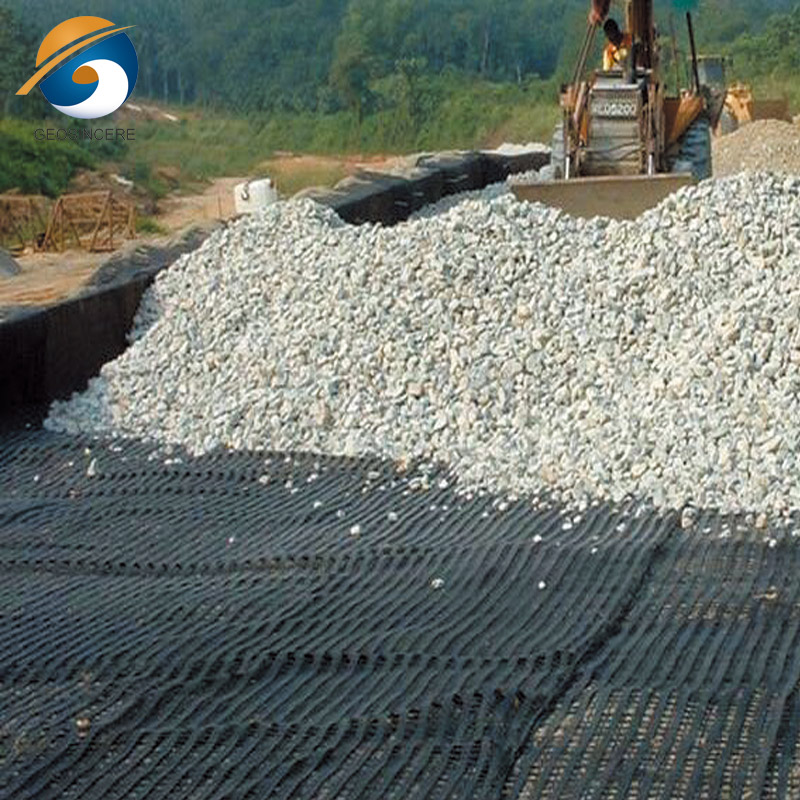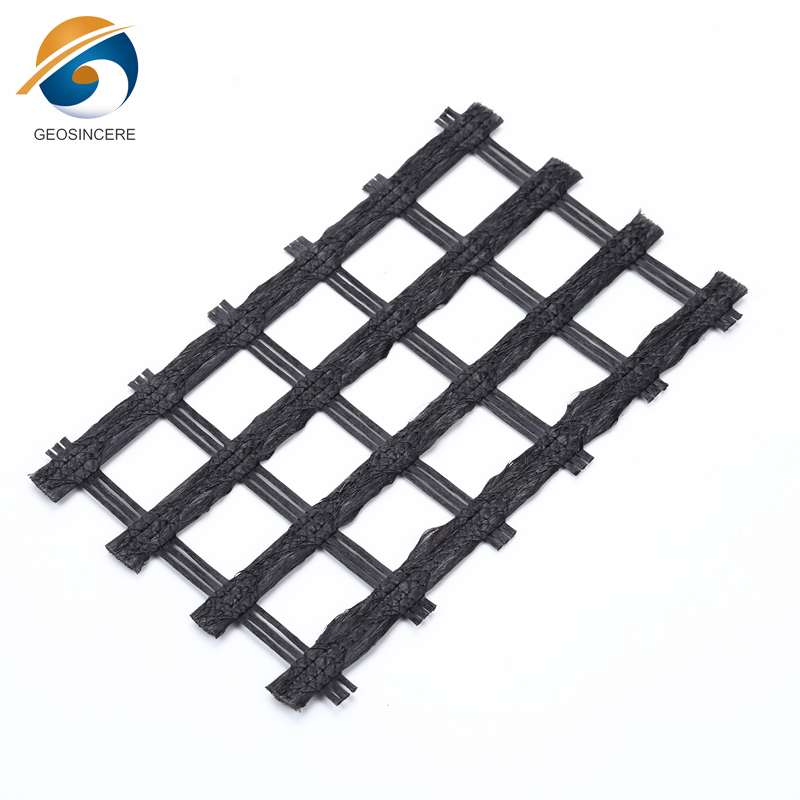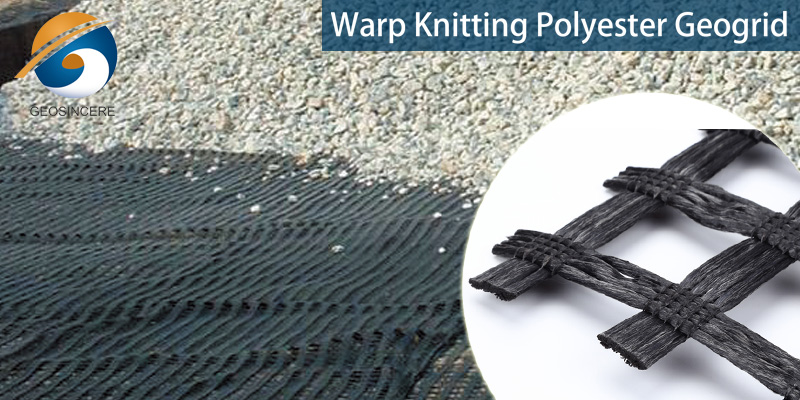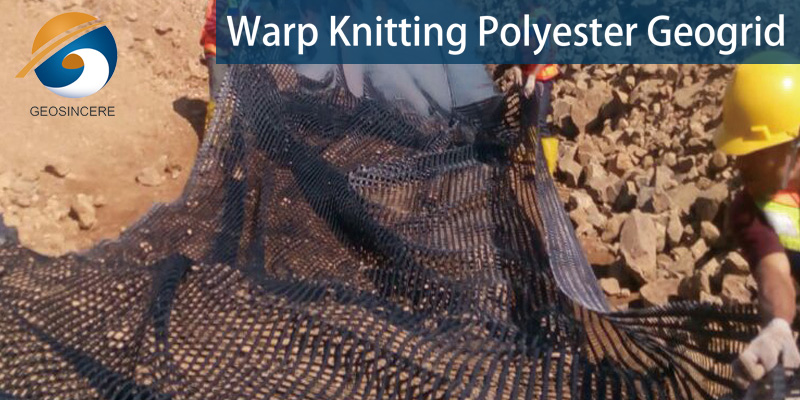Reinforced Warp Knitting Polyester Geogrid for Mining
Warp knitting polyester geogrids have excellent tensile strength, which allows them to withstand high loads and distribute forces effectively. They provide reinforcement to the soil or rock mass, enhancing stability in mining applications.These geogrids are engineered to be durable and resistant to environmental degradation. They have good resistance to UV radiation, chemicals, and abrasion, ensuring long-term performance in harsh mining conditions.
Reinforced warp knitting polyester geogrids are lightweight, making them easy to handle and install in mining operations. Their lightweight nature simplifies transportation and reduces installation time. The grid-like structure of warp knitting polyester geogrids provides an open area that allows for efficient interlocking with soil or rock particles. This interlocking mechanism enhances the geogrid's ability to transfer loads and improve stability.
Reinforced warp knitting polyester geogrid is a type of geosynthetic material used in civil engineering and construction applications. Geogrids are typically made from high-strength polyester or polypropylene fibers that are woven or knitted together to form a grid-like structure. These grids are then coated or laminated to provide additional reinforcement and protection.Polyester is a common material used in geogrid manufacturing due to its high strength, resistance to chemical degradation, and durability. The reinforced nature of the geogrid means that it has added strength and stability compared to non-reinforced geosynthetics.
Geogrids are used to improve the stability and load-bearing capacity of soils. They are commonly used in the construction of roads, railways, embankments, and retaining walls.Geogrids can be installed to reinforce steep slopes and prevent soil erosion. They provide additional tensile strength to the soil, improving its stability and preventing slope failures. Geogrids are commonly used in the construction of retaining walls to reinforce the soil and distribute the lateral earth pressure. This helps to increase the stability and lifespan of the retaining wall.
Parameter
ltem | PET20-20 | PET30-30 | PET40-40 | PET50-50 | PET80-80 | PET100-100 | PET120-120 | |
Elongation (%) | 13% | |||||||
Intensity (kN/m) | Longitudinal | 20 | 30 | 40 | 50 | 80 | 100 | 120 |
Transverse | 20 | 30 | 40 | 50 | 80 | 100 | 120 | |
Grid (mm) | 12.7*12.7 25.4*25.4 | |||||||
Breadth (m) | 1-6 | |||||||
Reinforced Warp Knitting Polyester Geogrid for Mining Features
Excellent mechanical properties and long-term stability.
High tensile strength.
High wear resistance.
Anti-corrosion resistance.
Balanced vertical and horizontal strength.
Strong tearing resistance.
Excellent soil surface adaptability, especially the tilted or curved surface.
High resistance to dynamic impact load and vibration activity.
Strong strengthening ability.
Excellent resistance to differential settlement.
Easy to install.
Applications of Reinforced Warp Knitting Polyester Geogrid for Mining
In modern mining operations, ground stabilization and reinforcement are critical to ensuring structural integrity and operational safety. Reinforced warp knitting polyester geogrids have emerged as a preferred solution for soil reinforcement and slope stabilization in mining environments due to their high tensile strength, durability, and chemical resistance. This article provides an in-depth technical analysis of reinforced warp knitting polyester geogrids specifically tailored for mining applications, including their properties, relevant engineering principles, standards, installation practices, and regulatory considerations.
What Is Reinforced Warp Knitting Polyester Geogrid?
A warp knitting polyester geogrid is a geosynthetic material fabricated by interlocking polyester yarns in a warp knitting process, reinforced with additional coatings or polymers to improve mechanical performance. The reinforcement typically involves polymer coatings such as PVC or polyethylene, which enhance durability, chemical resistance, and UV protection.
Key Features:
Material Composition: High-tenacity polyester yarns (PET)
Manufacturing Process: Warp knitting with additional reinforcement layers
Tensile Strength Range: 20 kN/m to over 100 kN/m (depending on model)
Elongation at Break: Typically 3%–12%, providing high stiffness
Chemical Resistance: Resistant to oils, acids, alkalis common in mining environments
Temperature Range: Operational from -40°C to +80°C
Applications in Mining
Reinforced warp knitting polyester geogrids are primarily used for:
Slope stabilization on mine embankments and waste dumps
Subgrade reinforcement under haul roads and heavy vehicle paths
Retaining wall reinforcement in excavation and pit areas
Liner support in tailings storage facilities
Erosion control in reclaimed mining sites
Their high tensile modulus and resistance to mechanical damage make them ideal for challenging mining conditions involving heavy loads and aggressive chemical exposure.
Engineering Principles and Performance Parameters
Tensile Strength and Modulus
High tensile strength is essential to withstand ground pressure and dynamic loads. Typical values range from 20 to 100+ kN/m depending on geogrid design and reinforcement.
Modulus (stiffness) must be sufficient to limit elongation, ensuring dimensional stability.
Creep Resistance
Long-term load resistance (creep) is crucial in mining, where geogrids may be subjected to sustained heavy loads.
Polyester fibers reinforced with polymer coatings exhibit superior creep resistance compared to other materials like polypropylene.
Junction Strength
Warp knitted junctions provide dimensional stability and uniform stress distribution.
Reinforced coatings further increase junction strength and protect against abrasion.
Relevant Industry Standards and Testing Methods
ASTM D6637: Tensile properties of geogrids under controlled strain
ASTM D5262: Creep testing for geosynthetics
ISO 10319: Tensile properties of geotextiles and geogrids
EN 13249: Geosynthetic materials for civil engineering — geogrids specifications
Mining-specific regulations may require compliance with local environmental and safety codes, including slope stability factors.
Installation Guidelines and Operational Considerations
Subgrade preparation: Ensure a smooth, well-compacted surface free from sharp objects.
Overlap: Minimum 30 cm overlap between geogrid sheets to maintain tensile continuity.
Anchoring: Proper anchoring at edges to prevent slippage under load.
Protective layers: Application of a granular or soil cover to prevent direct UV exposure and mechanical damage.
Handling: Avoid dragging geogrid rolls over rough terrain to minimize damage.
Environmental factors: Monitor for chemical exposure and temperature extremes that may degrade the polymer coatings.
Example: Mining Road Reinforcement Project
In a case study involving haul road reinforcement in an open-pit mine, a reinforced warp knitting polyester geogrid with tensile strength of 70 kN/m was installed under a 30 cm granular base. After 12 months of heavy truck traffic, the road exhibited minimal rutting and significant load distribution improvement, reducing maintenance costs by 40%.
FAQs on Reinforced Warp Knitting Polyester Geogrid for Mining
Q1: Why choose warp knitting polyester geogrids over other materials?
A: They provide superior tensile strength, excellent creep resistance, and chemical stability, making them ideal for harsh mining environments.
Q2: Can these geogrids be recycled?
A: Polyester geogrids can be recycled, but the reinforced coatings may complicate processing. End-of-life recycling programs depend on local facilities.
Q3: What is the typical lifespan of a reinforced warp knitting polyester geogrid in mining?
A: Lifespan ranges from 15 to 25 years, depending on exposure conditions and maintenance.
Q4: Are these geogrids suitable for acidic or alkaline environments?
A: Yes, the polyester and coating materials resist a wide range of chemicals typical in mining operations.
Q5: How is the product tested for quality assurance?
A: Through tensile strength, elongation, creep resistance, junction strength tests, and UV resistance assessments per ASTM and ISO standards.
Conclusion and Call to Action
Reinforced warp knitting polyester geogrids represent a technically advanced and cost-effective solution for various reinforcement challenges in the mining sector. Their mechanical properties, resistance to environmental degradation, and compliance with rigorous standards make them indispensable for long-term infrastructure stability.
We invite mining engineers, project managers, and procurement professionals to consult with our technical experts to identify the optimal geogrid solution tailored to specific site conditions and regulatory requirements. Contact us today to receive detailed product specifications, custom project assessments, and competitive quotations.














